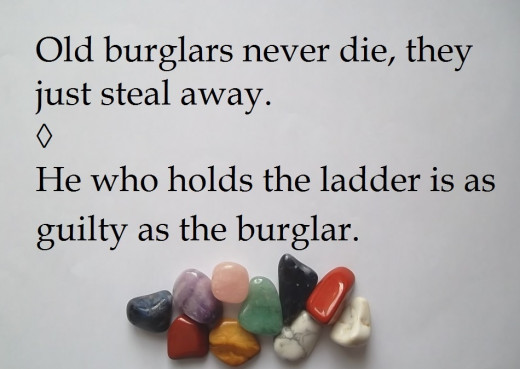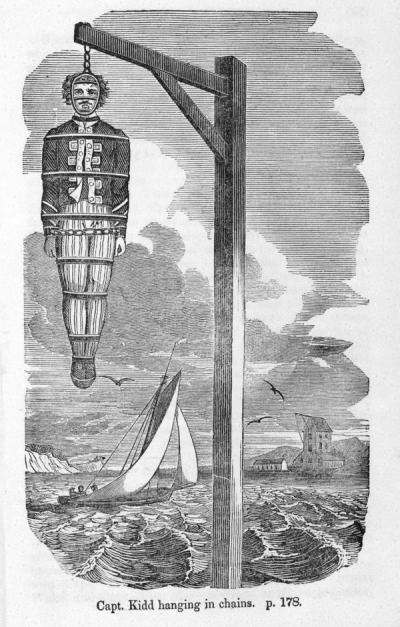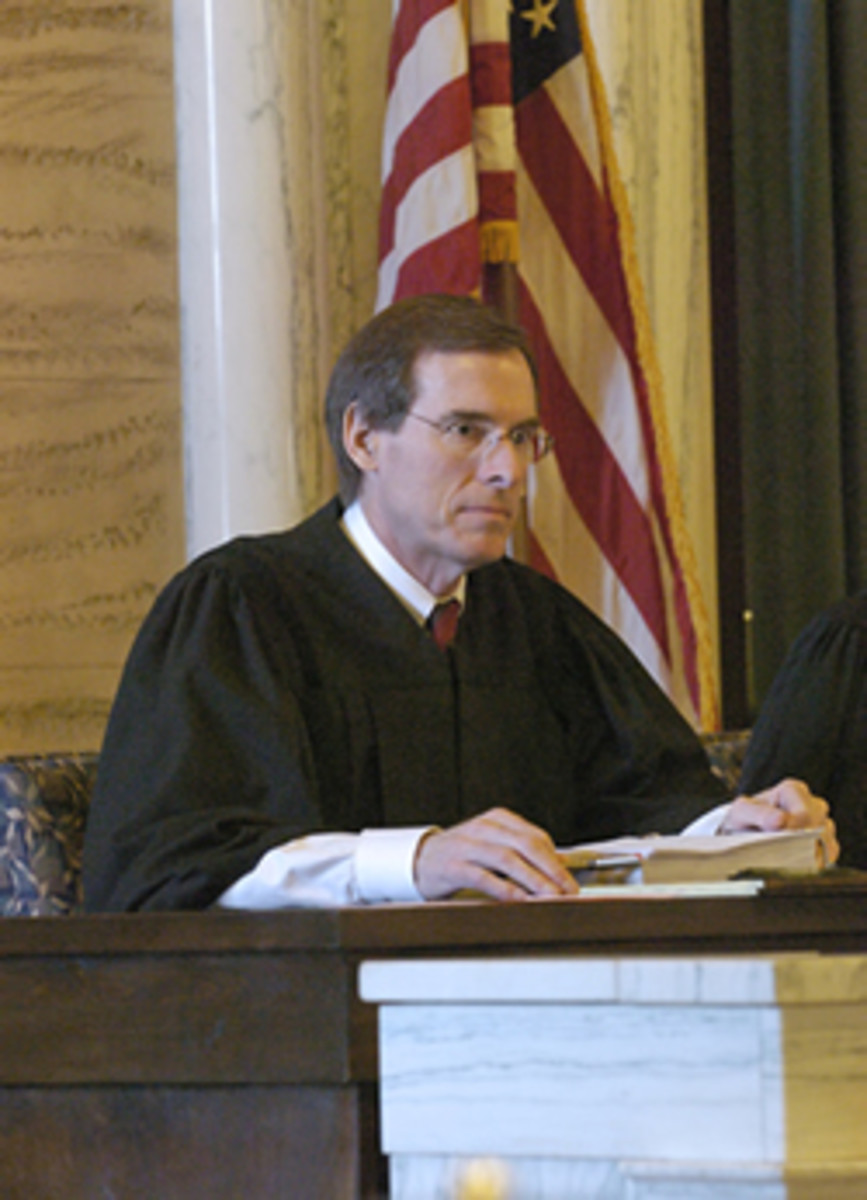The Felony of Burglary
What Constitutes Burglary?
In the public mind, such crimes as burglary, larceny and robbery are more-or-less synonymous. In truth, while similar in some respects, there are differences which are significant in a court of law in terms of the gravity of the offence and its consequent sentencing.
Some legal scholars believe burglary as a crime has become obsolete, its aspects absorbed by other offences. Still, so entrenched has it become as a cornerstone of common law that its withdrawal from the legal lexicon, if occurring at all, is sure to be gradual.
If once a man indulges himself in felony, very soon he comes to think little of robbing; and from robbing he comes next to drinking and from that to incivility and procrastination
— Thomas De QuinceyWhen a felon’s not engaged in his employment or maturing his felonious little plans; his capacity for innocent enjoyment is just as great as any honest man’s
— W.S. GilbertThe Case Of Thomas Whitehead
The earliest recorded UK Court case of burglary was that of Thomas Whitehead in 1674. Arrested on suspicion of burglary, he was being held without bail in London’s Newgate prison when, due to the help of friends, he was able to obtain an order increasing his freedom of movement within the prison confines.
Apparently a bit of a dunderhead, Whitehead availed himself, on his first day of comparative freedom, of what he believed was a chance to escape. During the same day he released himself from captivity; Whitehead broke into a house and stole £4.
Once recaptured and returned to Newgate, a trial ensued for his most recent crime. During this second trial, the jury found Whitehead guilty of burglary. The Judge described him as notorious and incorrigible, in that he seemed incapable of learning from his earlier misdeed and its penalty. Thus, the judge sentenced him to death.

The Case Of The Wench With No Name
In 1677, a young woman denoted “a serving wench” was indicted as an accomplice in the burglary of her Masters home. This maid, being questioned in court, confessed that during the night of the crime, she secretly opened the servants outside door in order to allow two men to enter the house and steal property belonging to her employer.
Had it not rained on that night, she might have eluded suspicion. Unluckily for her, this rain caused the burglars to leave a trail of footprints, beginning outside, and then tracked inside the home.
Red Sand As Evidence
A trail of footprints from the pathway into the house was traced via red sand from the soles of the burglars’ shoes. This sand, later found on the wench’s slippers as well, linked her to the crime by showing her having, in following them, indented those same footprints with her own.
Having found her guilty, the Judge offered her what would today be deemed a plea bargain. The judiciary would show mercy if she would name the two burglars she had assisted. She responded with the names of her father and brother, apparently hoping the court, satisfied by her seeming candor, would dismiss the matter. If so, this assumption proved her undoing.
In fact, investigation made clear that both these relatives had been deceased for some time. This prevarication decided the wench’s fate, if anything, perhaps rendering it more severe than it might have been otherwise. At any rate, she was sentenced to death. (Ironically, there is no record of the two burglars ever being found and prosecuted.)
Rainer Maria Rilke Wrote:
It is so often on the name of a misdeed that a life goes to pieces, not the nameless and personal action itself, which was perhaps a perfectly definite necessity of that life and would have been absorbed by it without effort.

The Brutality Of Execution
The method of execution enacted in these two cases is not recorded, but was most likely to have been gibbeting or hanging in chains until dead. The cause of death would usually be the result of exposure to the elements or the consequence of prolonged dehydration. These forms of hanging were deployed until 1834.
Hanging In Chains

Captain Kidd
Captain William Kidd was a Scottish pirate who was found guilty of murder and piracy. He was hanged on 23 May 1701. Apparently the hang rope snapped and he was hanged a second time. His body was then put into the gibbet with chains and put on public display for three years.
From 1834 until 1861, the crime of burglary remained punishable by death via hanging by rope, a swifter, far more humane method of execution. Due to legislation passed in 1861, hanging for the crime of burglary was abolished.
Common Law And Its Development
The early common law definition of burglary was riddled with loopholes. In order to constitute a breaking and entering, some substantial large object would need to be removed to enable the entry. If any opening could be shown to have existed, it would disqualify the crime as encompassing burglary. Still, the opening of a closed but unlocked door has always covered this aspect.
In legal terms, breaking and entering was held in its literal sense. This meant that a burglar could enter a given dwelling via any opening without fear of being brought before a court of law for burglary. While various types of shops had begun to come into existence, they nearly always operated during daylight hours, when owners and employees were able to prevent break-ins or summon a constable to halt the actions of a would-be perpetrator.
Show me a community or a country where all the minor felonies are discouraged and I will show you one bereft of major goodness.
— John HeywoodAs time passed, common law restrictions have been adapted to the needs of modern society. Time and the type of building became irrelevant. Strictures surrounding breaking and entering took on the entry of a building at any time, for an unauthorised purpose.
Indeed, some jurisdictions maintain that if anyone lingers in a building after his real or pretended reason for being there has been satisfied, or hides in an outer area in order to commit a crime after closing hours, may be adjudged guilty of burglary.
As will be shown in the following case, NASA interns entering the complex by way of a key still fell within this purview. Although the primary thief and his two accomplices were interns at a major U.S. governmental facility, they were only allowed to enter for purposes connected with their authorised tasks.

Burglary Of Moon Rocks: The Chance To Own A Part Of The Moon
Defendant Thad Roberts was raised in a home so profoundly religious that his father, having learned he had been intimate with his then girlfriend, told him he was doomed to hell and would therefore be disowned by his family. Indeed, any verbal or even visual contact could jeopardise eternal fate of any family member.
It is far too easy to attribute and blame the commission of any crime to the upbringing of a defendant. Still, any applicant for an internship at NASA is almost certainly impelled by an urge to reach towards the outer edge of reality, ideally soaring beyond it.
A Corner Of The Moon
Having obtained his position as intern, Thad Roberts found himself in a setting where even the sky could maintain no definitive boundaries. At first, Roberts felt overwhelmed by his opportunity to associate with some of the most venerated minds in this field. Then, by degrees, this humility began to evolve into a level of arrogance.
At this point, Roberts experimented and encourage his fellow interns to compete in risks barely within their allowed parameters. Then, having been told by one of the most eminent NASA space scientists that a cluster of rocks brought down from the moon had no value to NASA, Roberts began to imagine the life he could revel in if he could obtain and sell these rocks to collectors for whom they would have a worth beyond price.
Gradually, the idea took root. By way of a rationale, Roberts concluded that one could not steal, in a genuine sense, items which had no value to their possessors. Hence, the taking and selling of them would enable him to offload his large student debt, provide support for his estranged wife and their coming baby, and most vitally to him at the time, permit him, without guilt, to travel wherever he wished with a fellow intern Tiffany Fowler who he believed to be his ultimate partner.
Joined in a cutting edge effort, their amalgamated knowledge and impetus seemed bound to benefit the scientific and then the global community.

A Mortal’s Chief Enemy
As Shakespeare states in Macbeth, security is a human being’s most lethal foe, urging an otherwise prudent thinker to avail himself of foolhardy chances. Thus, by the time Roberts’ plan was approaching fruition, he had gained sufficient trust to be allowed to view the most sensitive information in NASA’s innermost sanctums.
Given this information, with the help of Tiffany Fowler and another close female friend, both NASA interns, invaded the most private sphere of the building within NASA’s complex. Having used his key to enter the building they located the safe containing the moon rocks, but were unable to open it. Undeterred they put the safe onto a trolley and wheeled it out of the building to a waiting vehicle driven by accomplice Shae Saur.
The title of Ben Mezrich’s book Sex on the Moon derives from Roberts’ having placed a fragment of rock underneath the sheet of the bed, in a nearby hotel room, where he and his girlfriend made love shortly thereafter.
An Earthbound Accomplice
A vital part in this plan consisted of the background work of a young man who, while having no link with NASA, possessed a good deal of savvy in terms of the ways of trading. As Roberts’ plan grew, this trader sent out emails to various potential buyers for these most exotic rocks. Although dismissed by most as a hoax, Axel Emmermann, a long-time member of a Belgian mineralogy club, thought it worth delving into further.
While never intending to purchase rocks, the origin of which he knew must have been illegal; he suspected there were actual moon rocks for sale. Then, by a series of carefully calibrated emails, he persuaded Roberts, via his conduit, to sell these treasures on his behalf to a pair of FBI agents. These agents posed as Emmermann’s American Sister-in-law, married to his Belgian brother.
Having driven with Roberts to his point of readiness to exchange his contraband for cash, these FBI agents left the car, joined with colleagues, then arrested Roberts and Fowler. Shortly after their arrest, Fowler confessed the entire plot and its result to her father, and opened it to the police. This confession, compounded with their secondary roles in this heist, freed the two young women from later imprisonment.
In 2003 Roberts was sentenced to eight years’ incarceration, which on appeal was reduced by ten months.
Tragic Loss
The moonstones were returned to NASA. However, the safe had also contained the notes of Dr. Everett K. Gibson Jr covering thirty years of unique research about the Apollo program; these were lost or destroyed.
A Blundering Burglar
Over-all, the UK, U.S. and Canada tend to share similar legal concepts, though terminology may differ in terms of statutes and acts.
Thus, an earlier, more flagrant example regarding the view of unauthorised entry is encapsulated in the 1979 UK case of R. v. Walkington. Here, Walkington entered a branch of Debenhams Department Store, ostensibly to buy an item he believed the store might provide.
Debenhams Store: Leeds UK

While the employees were occupied elsewhere, Walkington sauntered behind a movable counter. Seeing one drawer of a till left open, he found it empty. He slammed it shut, and then proceeded to open a closed one. Any hopes he held of acquiring cash were quashed when he was halted by staff who detained him and summoned the police. Walkington was arrested.
At his trial, his claim that he had been unaware of the barrier posed by the counter was dismissed by the court as lacking validity-in essence, ludicrous. The separation, however slight, between that area available to customers and that permitted only to employees was held to have been distinct and definite.
Public invitation to enter a shop, the court stated, extends only in the browsing section. This does not encompass that area where actual commerce takes place. Hence, Walkington was convicted of burglary.
The Naked Burglar
R v Collins 1972
This case of burglary with intent to rape engenders intriguing issues, and revolves around two legal concepts.
1. Trespass to land is the entry onto a person’s land or property without permission.
2. Burglary involves the entry into any building or part of a building as a trespasser and with intent to commit a crime.
Hence: Trespass is an essential element of the offense of burglary.
Case Background
Both parties to this crime, in their late teens, had enjoyed an evening of fun, ending in general inebriation. The plaintiff, an 18 year old girl, out for the evening with friends and her blond haired boyfriend, had consumed a substantial amount of alcohol. The defendant Collins, also blond-haired but not the girl’s boyfriend had also been out drinking with friends.
As Collins walked towards his home in an amorous mood, he apparently thought of a girl he had met while hired to do maintenance work in her mother’s home. During his work, he had ascertained the location of her bedroom. He had also noted that her bedroom window tended to be open during the night. Given his dare-devil mind-set, he decided to avail himself of the chance of becoming intimate with this young woman.
A Lusty Lad With A Ladder
Using a ladder, Collins climbed up to the girl’s open bedroom window where he saw her lying asleep in the nude on her bed, not far from the window. Collins then climbed back down the ladder and removed his clothing, then climbed back up the ladder to the window.
Perhaps apprised by some noise of a young man’s approach, the girl woke up. Seeing a naked young man in the moonlight, she assumed him to be her boyfriend. In this belief, she beckoned Collins to come to her bed. Whilst making love she noticed that his voice and physical shape was not that of her boyfriend. Having switched on her bedside lamp, seeing her lover was Collins; she slapped his face and told him to leave. At that, Collins fled.
Collins was later charged with burglary with the intent to commit rape.
He could not be charged with actual rape because the girl had consented albeit to the wrong man.
The Court Case
In court it was submitted that he had no case to answer on the grounds that the evidence did not support the charge, in that he had not entered the house as a trespasser. The submission was overruled by the judge. In fact it had not been ascertained whether Collins had been outside or inside the window at the time of the invitation, and neither party could provide an accurate memory of that event.
The judge had considered that the home owner, the girl’s mother, had not given Collins permission to enter the home and that he had entered the premises aware that he was trespassing.
Collins was sentenced to twenty one months in prison.
Under section 9 of the Theft Act of 1968, a person is guilty of burglary if he enters any building or part of a building as a trespasser and in this case with the intention of committing rape, however the entry of the accused into the building must first be proved.
Collins Appealed Against His Conviction
The appeal was allowed on the basis that the jury was not asked to consider the pivotal question as to whether Collins entered the premises as a trespasser, i.e. did he have or not have an invitation to enter. The appeal court decided that the judge had misdirected the jury on this point. It was also held that consent of the home owner (the girl's mother) was not required; it was sufficient that the girl had invited him in.
Collins conviction was subsequently quashed.
You can read the appeal decision in detail here
Note
Collins could not be charged with rape because consent was given. This loophole in the law was closed by the Sexual Offences Act 2003 c.42 Part 1.
Rape
(1)A person (A) commits an offence if—
(b)B does not consent to the penetration, and
(c)A does not reasonably believe that B consents.
(2)Whether a belief is reasonable is to be determined having regard to all the circumstances, including any steps A has taken to ascertain whether B consents.
Albert DeSalvo The Boston Strangler

Constructive Breaking And Entering
Constructivity is a concept which permeates every aspect of law. Its definition cannot be concrete in that each case is fact sensitive. This means the specific facts and circumstances involved comprise a major role in every judicial decision. Hence, in a landlord/tenant scenario, a tenant may succeed in a claim of constructive eviction if a landlord creates detrimental conditions or knowingly allows deterioration to reduce a rented property to a state which renders it uninhabitable.
In legal parlance, just as breaking and entering are often linked so closely as to be called “B&E”, constructive breaking and entering are akin in that Case law has established breaking as fraudulent entry.
The common law requirement of trespass is also similar to the idea of constructive breaking, as both involve unauthorised entry.
If someone intending to commit a crime obtains entry via misrepresentation, permission to enter has not, in the actual sense, been obtained. This means a burglary has occurred as definitely as if a perpetrator has taken a hacksaw to a door in order to force its opening.
Viewed within this framework, Albert DeSalvo, dubbed “the Boston strangler” during the 1960s, burglarised his way into a series of apartments. One of his cleverest ruses consisted of making the meowing sound of a kitten outside the door of a woman he had ascertained to be living alone. Once she had opened the door, DeSalvo would push the tenant aside in order to enter her apartment.
A more frequent pretence lay in DeSalvo’s claim to be a maintenance man sent by a landlord to provide painting and/or other household repairs. If his prospective victim proved reticent to let him enter her flat without prior notice, DeSalvo would warn that her lack of co-operation could lead to a long, perhaps endless delay. As to his assumption of the need for such repairs, he surmised, almost always correctly, that most women living alone had made some request to a landlord which had met with procrastination.
An Equal Opportunity Rapist
Beginning on June 14th 1962, a number of women ranging in age from 19 to 80, died as a result of DeSalvo’s obtaining access to their apartments. Once inside a woman’s flat with the door closed securely behind him, DeSalvo seems to have shed any pretense of being there for any acceptable purpose. Power then became paramount. The age or attractiveness of a victim was not a factor in whether or not he ordered her to remove her clothing and succumb to his forceful demands.
Whether or not intimate contact occurred, the encounter ended with DeSalvo’s strangling the woman to death, often with one of her own nylon stockings. In time, he tied this stocking into a bow just below the victim’s throat, as a “catch me if you can” taunt to law enforcement authorities. During those years prior to DNA testing, he might have remained untraceable, had he ceased his spree before being linked to these killings.
How Was He Halted?
On October 27th 1964, a woman DeSalvo attempted to kill was able to escape him and give identifying details to the police. This resulted in his arrest, conviction, and later incarceration. (Later, following an escape attempt, he was transferred to a higher security correctional facility. Eventually, during one morning inspection, he was found dead in his cell as the result of stab wounds inflicted by a fellow convict.)
Who Was Albert DeSalvo?
By way of a brief chronology, DeSalvo was born in 1931 into a disastrous family. His father, alcoholic and violent, taught the young DeSalvo to steal as a means of augmenting the family income. Later, having married, DeSalvo found much of his wife’s affection and tenderness absorbed by a daughter with a chronic bronchial condition.
While undoubtedly having suffered from various types of boyhood abuse, he was probably more than usually susceptible to a sense of marital neglect and abandonment. Still, others in similar situations have led fruitful lives, causing no harm to others.
Since the 1950s and 1960s, forensic psychological understanding has evolved a great deal. Internet access has made it easier to track a criminal’s history and go some way towards forestalling offences of deepening gravity.
Between 1956 and 1962, DeSalvo had spent 11 months in jails due to a series of crimes all of which encompassed breaking and entering. Given our modern view, we can only wish these consistent aspects had been treated as indicators of more deadly propensities.
DNA Crosses The Boundaries Of Time
There has since been doubt as to whether DeSalvo was in fact the Boston Strangler. Susan Kelly, author of the 1996 book The Boston Stranglers argues that the strangling’s were the work of several killers rather than a single individual. This was supported by FBI profiler Robert Ressler, and John E. Douglas. In 2000, attorney Elaine Sharp took up the cause on behalf of his family
In July 2013 the body of DeSalvo was exhumed and his DNA was compared to that found at the 1964 murder scene of his final victim 19 year old Mary Sullivan. The comparison proved positive.

DNA Testing: An Evidence Landmark
Deoxyribonucleic acid (DNA) is a molecule that carries the genetic instructions of all living organisms. No two DNA can be the same in structure and therefore can be used to identify an individual. Forensic science calls this “DNA profiling” and it was developed in 1984 by the British geneticist Sir Alec Jeffreys.
Profiling was first used as an evidentiary tool in 1988 to convict Colin Pitchfork for the Enderby murders. He raped and murdered 15 year old Lynda Mann in 1983 and 15 year old Dawn Ashworth in 1986.
Initially the prime suspect for these two murders was a Richard Buckland who would have been found guilty. However he became the first person to have his innocence proven via DNA testing.
A Mans Home Is His Castle

Castle Law
What level of force is acceptable in defending one’s home against the inroads of an intruder? The answer lies in what can be said, in legal terms, to constitute a home, and thereby its owner’s castle.
Over-all, such a castle is viewed as an area in which an individual should feel a sense of unassailable fortress from any unauthorized entry. In a general sense, this includes not only a home, but also an office or private vehicle. The concept of curtilage is similar in that it embraces outbuildings which constitute a part of a homeowner’s life. This means a garage, barn, stable or nearby storehouse is also covered within this framework.
Still, the concepts of castle law and curtilage differ somewhat in the requirements of force permitted by law in their protection. The rights of an owner are strongest when a burglar has entered his actual dwelling. The degree of force used to defend must have an equivalent in the reasonable belief in the burglar’s proven intent.
Hence, lethal force can only be deployed where the victim can show a justified belief that deadly force seemed likely to be used against him. This means that, even if an elderly individual’s life savings have been invested in a Rembrandt painting which a burglar is about to rip from his wall, the victim cannot kill the burglar strictly upon this basis.
Conclusion
For a few decades, the law allowing the right to stand one’s ground came into conflict with the duty to retreat statutes set forth in some U.S. jurisdictions.
Currently, there has been a general acceptance of a middle ground. While a burglarized home-owner is not permitted to resort to shooting or garroting a burglar after having knocked him unconscious, the view of Justice Oliver Wendell Holmes is retained: one cannot be expected to take an objective view when his life is at knifepoint.
© 2014 Colleen Swan







